|
| |
- This page contains pictures and information about Wasp Moths and Spotted
Tiger Moth of subfamily Ctenuchinae
that we found in the Brisbane area, Queensland, Australia.
-
-

- This Wasp Moth
is trying very hard to convince us that we are dealing with a wasp.
-
- The caterpillars in Ctenuchinae are usually covered with uniform dark
hairs. Most of them are active during the day. They may look like those caterpillars in family
Anthelidae but the hairs are shorter and with no pattern on the head.
They pupate in cocoon made of
silk and their hairs. Caterpillars may be find on ground, under logs and
other debris. They feed on fallen leaves and other dead plant materials.
-
- Adults in Ctenuchinae are small to medium in size. Their abdomen are
usually banded with black and orange colours, mimicking wasp. This is the warning colours of
they are poisonous or distasteful if eaten. Most of them looked very
similar. It is believed that they mimic each other and form a mimicry
complex. Their fore-wings are relatively long and narrow with small
round hindwings. Their wings are usually black in colour with orange or
semitransparent spot patterns. They usually have their wings held out and flat when rest. They are active during the day.
-
-
We noticed that those species in this sub-family spend quite a long time in mating.
Most of their
pictures, from reference books or other web sites, show they are mating. This is not the case for other moth species.
-
- In Brisbane we found a number of species in genus Amata. All of them have
the very similar wing patterns. We believed they formed the Mullerian
mimicry complex.
-
- Common Wasp Moth
  - Eressa angustipenna, wingspan 30mm
- This moth is common in Brisbane bushes. We easily find them resting or
flying openly in the Eucalyptus forest during the warm seasons. Its
wings are black with translucent yellow-orange spots. It has black and orange-yellow bands on its
abdomen. There is the orange band between its black head and black hairy
thorax. Its forewings are long and a bit narrow. Its hind wings are
relatively small. For more pictures and information please click on here.
-
-
- Unknown
Wasp Moth

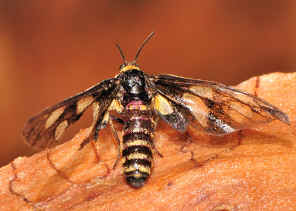
- Eressa sp. wingspan 30mm
- We found this Wasp Moth under loose bark. It was in Carbrook
Wetland on Nov 2009. This may be a wear-off Eressa angustipenna (species
above).
-
-
- Hourglass Wasp Moth
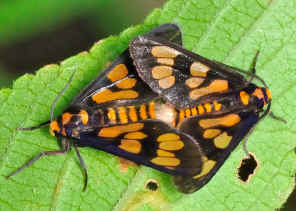 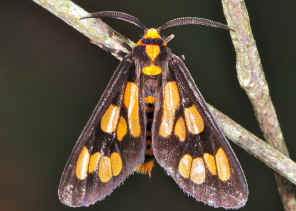 - Eressa geographica, body length 20mm
- We found the above mating couple in Karawatha Forest in late summer. We also
found them near Stockyard Creek. This moth look similar to the Wasp Moths (above).
We distinguished them by the orange-yellow hourglass patterns on thorax.
This moth is quite common in Brisbane bushes.
More information and pictures please visit this page.
-
-
- Orange-headed Wasp Moth
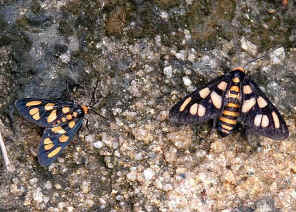  - Amata annulata, wingspan
30mm
- This moth has the black hairy thorax, orange head with black eyes. Its
wings are black with translucent yellow-orange spots. It has black and orange-yellow bands on its
body. The Caterpillar is black with brown hairs. Please also
check this page for more information.
-
-
- Orange Shoulder Wasp Moth

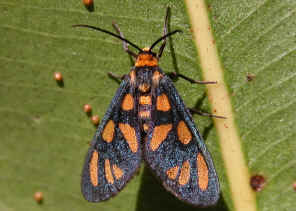 - Amata humeralis, wingspan
30mm
- This moth is fairy common in Brisbane bush. We sometimes find them resting or
flying openly in the Eucalyptus forest. This moth has the orange hairs on
the forewings base. This is why we called them Orange Shoulder Wasp Moths. More pictures and information please
visit this page.
-
-
- White Antenna Wasp Moth
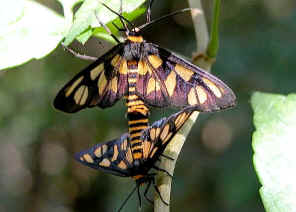  - Amata nigriceps, wingspan
30mm
- This moth has the black hairy thorax, orange head with black eyes. Its
wings are black with translucent yellow-orange spots. It has black and orange-yellow bands on its
body. Notice its antenna have the white tip. Please also visit this page for more information.
-
-
- Black Thorax Wasp Moth

 - Amata trigonophora, wingspan
30mm
- We distinguished this Black thorax Wasp Moth
by the long black hairs on thorax. The whole antennae are also black in
colour. This moth is not common in Brisbane bushes. Please check this page
for more information.
-
- Reference:
- 1. CTENUCHINAE
of Australia - Australian
Caterpillars by Don Herbison-Evans & Stella Crossley,
2007.
- 2. Insects of Australia and New Zealand - R. J. Tillyard, 1926,
p444 (Syntomidae).
- 3. Insects
of Australia, CSIRO, Division of Entomology, Melbourne University
Press, 2nd Edition 1991, p910.
- 4. Moths
of Australia - I. F. B. Common, Melbourne University Press,
1990, p438.
- 5. Moths
of Victoria: part two, Tiger moths and allies Noctuoidea (A) - Peter
Marriott, Entomological Society of Victoria, 2009.
- 6. Amata {genus} - The Barcode of Life Data System
(www.barcodinglife.org),2011.
- 7. Eressa {genus} - The Barcode of Life Data System (www.barcodinglife.org),2011.
-
- [ Up ] [ Arctiinae ] [ Lithosiinae ] [ Ctenuchinae ]
Back to Top
| |
|















